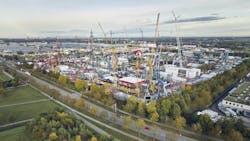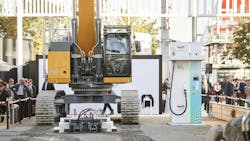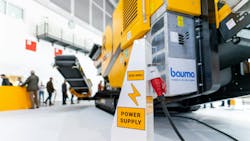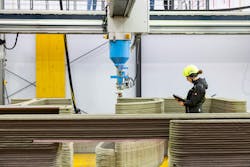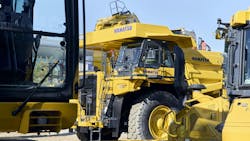bauma 2025 to Showcase Major Industry Trends in Construction and Mining
Held once every 3 years, bauma brings together exhibitors and attendees from all over the world to showcase the latest technological developments for the construction and mining industries. Machines, services and componentry of various types will be on display, including hydraulics which are vital to the operation of construction and mining equipment.
Besides the many technologies exhibited, each edition of the show shines a light on the major trends impacting both industries. These trends will be reflected in the five key topics show organizer Messe München has chosen for the 2025 event:
Quick Stats About bauma 2025
Show organizers Messe München say there was high demand for exhibition space at bauma 2025 and the event is fully booked once again. “The persistently high level of interest in bauma underscores its global significance,” said Stefan Rummel, CEO of Messe München. “bauma is and remains the heartbeat of the industry and will continue to provide important impetus even in the challenging market environment of 2025.”
Following are some quick facts about the 2025 edition of bauma:
- Dates: April 7-13
- Location: Munich, Germany
- Over 3,500 exhibitors from 57 countries
- 614,000 sq. m of exhibition space (equivalent to 86 soccer fields)
- About 150 new exhibitors
- Close to 50 start-ups showcasing their innovations
- Increased interest from international companies, primarily Asia
- European exhibitors continue to have the strongest presence
- climate neutrality
- alternative drive concepts
- networked construction
- sustainable construction
- mining challenge.
5 Key Topics Demonstrate Driving Forces in Construction and Mining
Messe München worked together with its partner VDMA Construction – Equipment and Plant Engineering and various other industry associations as well as industry representatives to select the five key topics of bauma 2025.
Stefan Rummel, CEO of Messe München, said during a press briefing about the 2025 show that the company works with a lot of associations and exhibitors from around the world to understand what’s going on in their respective countries as well as the global industry.
“We learn a lot along the way,” he said. “What are the hot topics of the industry? How is the transformation going? What are the challenges with the current economic situation of the industry?”
These discussions help shape how bauma is put together in terms of exhibition space and conference programs, including the determination of the event’s key topics.
Rummel said the construction and mining industries are in a period of transition, like many other sectors, with the megatrends of sustainability and digitalization being key drivers which are affecting the industries on many levels. Each of the key topics chosen for bauma 2025 are related to these megatrends.
bauma FORUM, the event’s conference program, will dedicate one day each to the key topics. It will offer presentations and panel discussions on subjects related to the topics including new technological developments, regulatory information and more.
Climate Neutrality
In 2019, the European Union (EU) established a goal of reaching climate neutrality by 2050. Other countries around the world have put similar goals in place as well.
Per Messe Munchen, the construction industry is estimated to contribute about 36% of carbon emissions to the total produced within the EU. Therefore, the industry is looking for ways to reduce its carbon footprint in the EU and around the world.
Improving machine efficiency is one of the ways Messe Munchen said the construction industry is working to reduce its emissions output. Component and system suppliers as well as OEMs are finding ways to increase efficiency.
Doing so reduces energy drawn from the engine or battery powering the machine, leading to fewer emissions produced. For battery-powered machines, it leads to longer run times and thus fewer breaks to recharge.
Improving efficiency is an area in which many hydraulics manufacturers are working; hydraulics have traditionally been considered to be inefficient but technological advancements in recent years have helped overcome this stigma. And with the move toward electrification in many applications, the need for efficient hydraulics has increased further.
Watch our interview below with Lucas Knapp, Vice President of Product & Marketing at HARTING and Dr. Andreas Schumacher, Senior Director, Head of Sustainability and Product Compliance at Danfoss Power Solutions to learn how energy efficient technologies can aid sustainability efforts.
Digitalization and automation solutions, many of which will be on display at bauma 2025, are other methods being employed to achieve carbon neutrality. Digital technologies allow for better planning of how best to use machines, such as avoiding long idle times, while sensors can monitor machine performance including increases in energy consumption.
Automation, on the other hand, can be used to ensure work is completed as desired which eliminates the need to redo tasks, causing increased use of fuel.
Alternative Drive Concepts
Per Messe Munchen, construction machinery worldwide emits several hundred million tons of carbon dioxide every year. As part of the industry’s efforts to reduce its emissions output, it has been moving away from diesel engines toward electric and other alternative powertrain technologies including hydrogen.
OEMs and component suppliers alike — including those in the fluid power industry — are developing electrification, hydrogen and other solutions to reduce or even eliminate emissions from construction equipment, mining machinery and more.
Several companies exhibiting at bauma 2025 intend to highlight their developments in this area. Volvo Construction Equipment, for instance, plans to unveil its newest zero-emission machine and showcase its all-electric lineup. The company has been at the forefront of the electrification movement in the heavy equipment industry and continues to add new machines to its offering.
Hydraulics remain an important part of these machines as well, demonstrating the continued role of fluid power in this space. Companies such as Danfoss Power Solutions, Parker Hannifin, Poclain Hydraulics, Bosch Rexroth and many more will be highlighting their developments in this area during bauma.
While electrification has progressed in recent years, there are still many challenges to overcome. Compact machines are for now the segment in which battery power is most prevalent because of their power requirements. As machines increase in size so do the batteries and other components required which is still a challenge to achieve in many instances.
Charging infrastructure and charging times remain a challenge for the industry as well. Many OEMs have begun introducing mobile chargers for use at construction and other work sites to help overcome this. And developments are in progress to reduce charge times.
Besides electric powertrains, alternative fuels such as hydrogen and hydrogenated vegetable oil are under investigation. Much of this work is still in the concept stage, although JCB has demonstrated the ability to utilize a hydrogen fueled engine in some of its machines.
Networked Construction
Messe Munchen describes networked construction as the incorporation of digital technologies and communications into construction processes. Doing so can help to improve collaboration and efficiency.
Integration of such technologies within machine attachments, for example, can help to process data which can then be sent to the equipment operator to help them better understand the work at hand and make any adjustments as needed.
The MiC 4.0 BUS protocol introduced at bauma 2022 provides a standardized digital language for communication with machine attachments. Messe Munchen explained the common universal protocol enables the machine to recognize which attachment is to be used, which parameters it needs to function, and whether it is even suitable for use on the machine. This is similar to the ISOBUS concept in the agricultural machinery industry.
“Accidents caused by incorrectly closed quick hitches, unsuitable hydraulic pressure or incorrectly dimensioned attachments can thus be reliably avoided,” said Dr. Darius Soßdorf, Managing Director of the MiC 4.0 working group at VDMA.
With the increase in digitalization in the construction industry, machine operators and owners can gather a wealth of data to help improve their performance and overall business operations. Data can help them see how much fuel is being used, be more proactive with maintenance to avoid unplanned downtime and more. All of this leads to more productive and efficient operations for improved business outcomes.
Sensors a key part of the digital transformation, enabling the collection of data, monitoring of performance conditions as well as control of various aspects such as hydraulic cylinder position.
Sustainable Construction
Creation of a more sustainable construction industry includes not only reducing emissions from machinery but also finding ways to use less resources or produce various goods.
One method for lowering the amount of materials utilized in the sector is a concept called serial construction. Items are manufactured in a facility and then assembled on site to enable better repeatability and efficiency.
“It uses raw and other materials more efficiently than with conventional construction methods, as prefabrication can be carried out in a controlled industrial environment,” explained Stephan Oehme, Consultant Mining & Minerals, Construction Equipment and Plant Engineering at VDMA.
Use of 3D printing is another avenue under investigation for sustainability. Messe Munchen said there is increasing use of recycled materials for 3D printing of buildings and materials, as well as research into the possibility of biobased materials. 3D printing itself, also referred to as additive manufacturing (AM), can benefit sustainability efforts as less material is typically used than with conventional manufacturing and there may be less need for machining.
Recycling as much as possible is another initiative within the global construction industry. Messe Munchen cited data from the Kreislaufwirtschaft Bau initiative which found that over 90% of the about 208 million tons of mineral construction waste generated in Germany was recycled. The organization notes companies like Wirtgen Group have developed systems such as cold recyclers to enable the reuse of asphalt pavement on a construction site.
Mining Challenge
The mining industry is being transformed by many of the same trends as the construction and other mobile equipment sectors, including use of alternative powertrains and digitalization.
However, this sector is also challenged with meeting ever-increasing global demand for raw materials. And like many other industries, it is facing a shortage of skilled labor entering.
Automation has therefore been an important technological development in this industry. For over a decade now there have been fully autonomous machines operating at mine sites around the world and more continue to be added every day.
Mining equipment is typically completing the same task over and over throughout the day, such as hauling material from one point to another, making it easier to automate these machines. The equipment also works on private sites, so there are fewer safety risks compared to implementing automation for on-road vehicles.
Automating machines may require fewer people to be on a job site as well, helping the industry’s labor shortage. Instead, workers may be in a remote location monitoring the automated machines to ensure they continue to work as desired. This may help to attract people to the industry who want to work with advanced technologies like automation as well as not have to go work in the very remote locations where mine sites are typically located.
Advancements in automation and other technologies for the mining industry will be on display at many companies’ booths during bauma 2025.
About the Author
Sara Jensen
Executive Editor, Power & Motion
Sara Jensen is executive editor of Power & Motion, directing expanded coverage into the modern fluid power space, as well as mechatronic and smart technologies. She has over 15 years of publishing experience. Prior to Power & Motion she spent 11 years with a trade publication for engineers of heavy-duty equipment, the last 3 of which were as the editor and brand lead. Over the course of her time in the B2B industry, Sara has gained an extensive knowledge of various heavy-duty equipment industries — including construction, agriculture, mining and on-road trucks —along with the systems and market trends which impact them such as fluid power and electronic motion control technologies.
You can follow Sara and Power & Motion via the following social media handles:
X (formerly Twitter): @TechnlgyEditor and @PowerMotionTech
LinkedIn: @SaraJensen and @Power&Motion
Facebook: @PowerMotionTech

Leaders relevant to this article:
